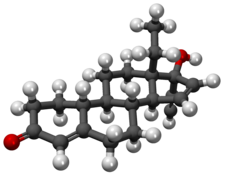 | |
 | |
| Clinical data | |
|---|---|
| Trade names | Femodene, Femodette, Gynera, Harmonet, Meliane, Minesse, Minulet, others |
| Other names | GSD; SHB-331; δ15-Norgestrel; 15-Dehydronorgestrel; 17-hydroxy-18a-homo-19-nor-17α-pregna-4,15-dien-20-yn-3-one; 17α-Ethynyl-18-methyl-19-nor-δ15-testosterone; 17α-Ethynyl-18-methylestra-4,15-dien-17β-ol-3-one; 13β-Ethyl-18,19-dinor-17α-pregna-4,15-dien-20-yn-17β-ol-3-one |
| AHFS/Drugs.com | International Drug Names |
| Pregnancy category |
|
| Routes of administration | By mouth |
| Drug class | Progestogen; Progestin |
| ATC code | |
| Legal status | |
| Legal status |
|
| Pharmacokinetic data | |
| Bioavailability | 96% (87–111%)[1][2][3] |
| Protein binding | 98% (64% to SHBG, 34% to albumin, 2% free)[4] |
| Metabolism | Liver (reduction, hydroxylation)[4] |
| Elimination half-life | 12–15 hours[2][4] |
| Excretion | Urine |
| Identifiers | |
| |
| CAS Number | |
| PubChem CID | |
| DrugBank | |
| ChemSpider | |
| UNII | |
| KEGG | |
| ChEBI | |
| ChEMBL | |
| CompTox Dashboard (EPA) | |
| ECHA InfoCard | 100.056.478 |
| Chemical and physical data | |
| Formula | C21H26O2 |
| Molar mass | 310.437 g·mol−1 |
| 3D model (JSmol) | |
| Melting point | 197.9 °C (388.2 °F) |
| |
| |
| (verify) | |
Gestodene, sold under the brand names Femodene and Minulet among others, is a progestin medication which is used in birth control pills for women.[5][6] It is also used in menopausal hormone therapy.[7] The medication is available almost exclusively in combination with an estrogen.[8] It is taken by mouth.[6][9]
Side effects of the combination of an estrogen and gestodene include menstrual irregularities, headaches, nausea, breast tenderness, mood changes, and others.[citation needed] Gestodene is a progestin, or a synthetic progestogen, and hence is an agonist of the progesterone receptor, the biological target of progestogens like progesterone.[10][11] It has weak androgenic activity, weak antimineralocorticoid activity, and weak glucocorticoid activity.[10][11]
Gestodene was discovered in 1975 and was introduced for medical use, specifically in birth control pills, in 1987.[4][12] It was subsequently introduced for use in menopausal hormone therapy as well.[7][8] Gestodene is sometimes referred to as a "third-generation" progestin.[13] It is marketed in birth control pills widely throughout the world, whereas it is available for use in menopausal hormone therapy only a few countries.[8][7] Gestodene is not approved in the United States.[14][15]
- ^ Cite error: The named reference
Mishell1999was invoked but never defined (see the help page). - ^ a b Stanczyk FZ (2002). "Pharmacokinetics and potency of progestins used for hormone replacement therapy and contraception". Rev Endocr Metab Disord. 3 (3): 211–24. doi:10.1023/A:1020072325818. PMID 12215716. S2CID 27018468.
- ^ Fotherby K (August 1996). "Bioavailability of orally administered sex steroids used in oral contraception and hormone replacement therapy". Contraception. 54 (2): 59–69. doi:10.1016/0010-7824(96)00136-9. PMID 8842581.
- ^ a b c d Cite error: The named reference
pmid8616979was invoked but never defined (see the help page). - ^ Elks J (14 November 2014). The Dictionary of Drugs: Chemical Data: Chemical Data, Structures and Bibliographies. Springer. pp. 595–. ISBN 978-1-4757-2085-3.
- ^ a b Morton IK, Hall JM (31 October 1999). Concise Dictionary of Pharmacological Agents: Properties and Synonyms. Springer Science & Business Media. pp. 132–. ISBN 978-0-7514-0499-9.
- ^ a b c "Estradiol/gestodene - Bayer Healthcare Pharmaceuticals - AdisInsight". adisinsight.springer.com.
- ^ a b c Cite error: The named reference
Drugs.comwas invoked but never defined (see the help page). - ^ Kuhl H (2005). "Pharmacology of estrogens and progestogens: influence of different routes of administration" (PDF). Climacteric. 8 (Suppl 1): 3–63. doi:10.1080/13697130500148875. PMID 16112947. S2CID 24616324.
- ^ a b Cite error: The named reference
FuhrmannSlater1995was invoked but never defined (see the help page). - ^ a b Cite error: The named reference
SchindlerCampagnoli2003was invoked but never defined (see the help page). - ^ Cite error: The named reference
RunnebaumRabe2012was invoked but never defined (see the help page). - ^ Carp HJ (9 April 2015). Progestogens in Obstetrics and Gynecology. Springer. p. 112. ISBN 978-3-319-14385-9.
- ^ Becker KL (2001). Principles and Practice of Endocrinology and Metabolism. Lippincott Williams & Wilkins. pp. 1024–. ISBN 978-0-7817-1750-2.
- ^ Jiang Q, He W (25 May 2016). Benefit-Risk Assessment Methods in Medical Product Development: Bridging Qualitative and Quantitative Assessments. CRC Press. pp. 135–. ISBN 978-1-4822-5937-7.